Pesticide Usage in Scotland: Outdoor Vegetable Crops 2017
This publication presents information from a survey of pesticide use on outdoor vegetable crops grown in Scotland during 2017.
General trends
Crop area
The census area of outdoor vegetable crops grown in 2017 was 19,336 hectares ( Table 21). This represents a 16 per cent increase from 2015 (3) and a 22 per cent increase from 2013 (4). Since the last survey, census areas of all vegetable crops have increased with the exception of leeks and turnips & swedes which decreased by 19 and four per cent respectively (Figure 1). The area of cauliflower increased by 51 per cent, cabbages by 36 per cent, Brussels sprouts by 34 per cent and carrots by 30 per cent ( Table 21).
In 2017, peas and beans accounted for 50 per cent of the outdoor vegetable crop area, leaf brassicas 21 per cent, carrots 20 per cent, turnips and swedes seven per cent and other vegetables two per cent (Figure 2).
Figure 1 Area of vegetable crops grown in Scotland 2013-2017
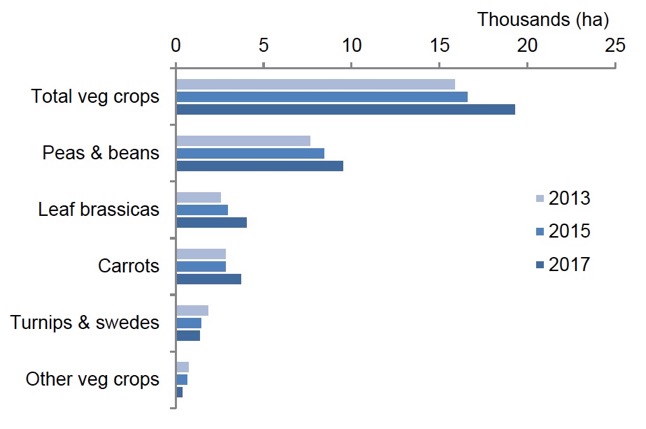
Figure 2 Vegetable crop areas 2017 (percentage of total area)
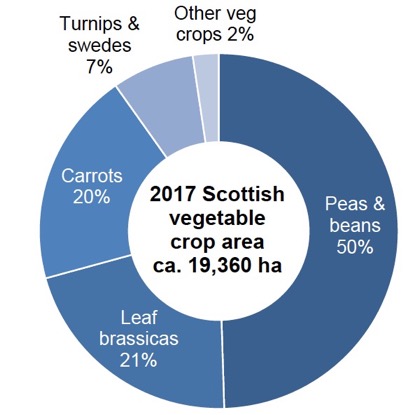
Pesticide usage
As in 2015, the majority of vegetable crops received a pesticide treatment in 2017 (98 & 93 per cent respectively). Vining peas, turnips & swedes, broad beans, calabrese and other brassica crops had the highest overall proportion of crop treated with a pesticide (94 to 100 per cent, Table 1). Cabbage, carrots and other vegetables were estimated to have lower proportions of treated crop (89, 76 and 60 per cent respectively). In relation to the average number of pesticide applications, the treated area of vegetable crops received on average 5.4 sprays, compared with 5.8 sprays in the previous survey. The other brassica category, which includes Brussels sprouts, received the highest number of applications with an average of 12.6 sprays. In contrast, vining peas received 2.3 sprays on average ( Table 1).
It is estimated that the area of outdoor vegetable crops treated with a pesticide formulation in 2017 was ca. 170,900 hectares compared with ca.179,000 hectares in 2015 and ca. 149,600 hectares in 2013 ( Table 20, Figure 3). This represents a decrease of five per cent since 2015 and an increase of 14 per cent since 2013.
Figure 3 Area of vegetable crops treated with the major pesticide groups in Scotland 2013-2017
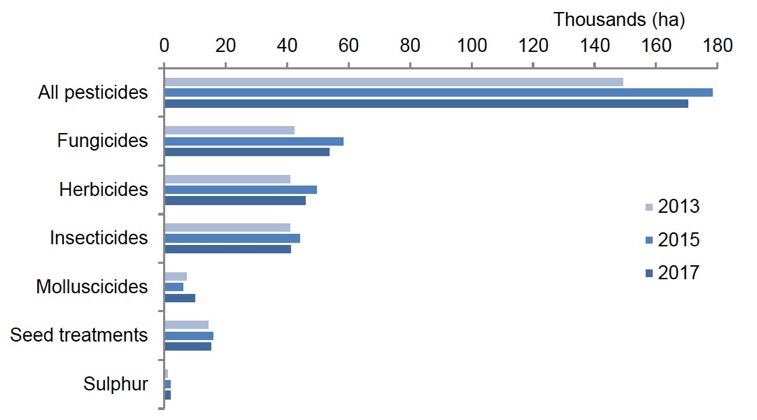
Note: growth regulators, biological control, biopesticides and physical control have all been excluded as their use represents <500 hectares
In terms of weight of pesticide applied, ca. 65.5 tonnes were applied in 2017 which was very similar to 2015 (67 tonnes) and an increase of 24 per cent from 2013 (53 tonnes) (Figure 4).
Figure 4 Weight of the major pesticide groups applied to vegetable crops in Scotland 2013-2017
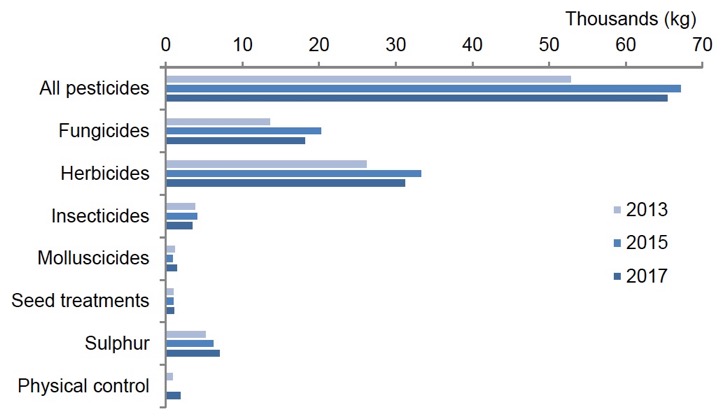
Note: growth regulators and biopesticides have been excluded as their use represents ≤500 kg
In order to make accurate comparisons between the 2017 data and that reported in previous surveys, it is important to take into account differences in crop areas between years. Therefore, the number of treated hectares per hectare of crop grown and the total weight of pesticide used per hectare of crop grown were calculated. When crop area is taken into account there is a decrease in the area and weight of pesticide applied (Figures 5 & 6). In 2017, for each hectare of crop grown, around nine pesticide treated hectares were recorded (Figure 5). This represents a decrease of 18 per cent from 2015 and six per cent from 2013. The estimated weight of pesticide applied per hectare of crop grown in 2017 was three kilograms (Figure 6). This is similar to the amount applied in 2013 but a decrease of 16 per cent from 2015.
Figure 5 Number of pesticide treated hectares (formulations) per hectare of crop grown
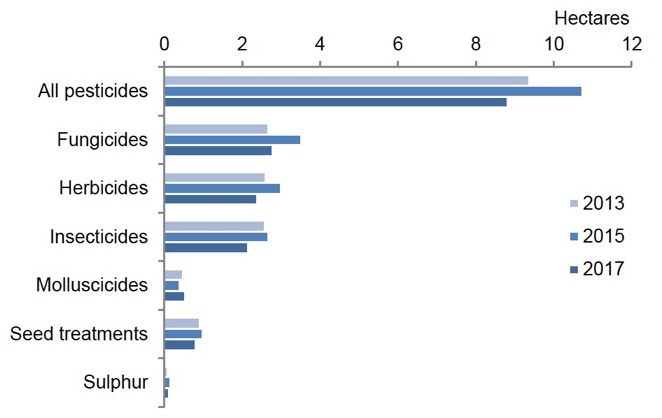
Note: growth regulators, biological control, biopesticides and physical control have been excluded as their use represents <0.1 treated hectares per hectare of crop grown
Figure 6 Weight of pesticides applied per hectare of crop grown
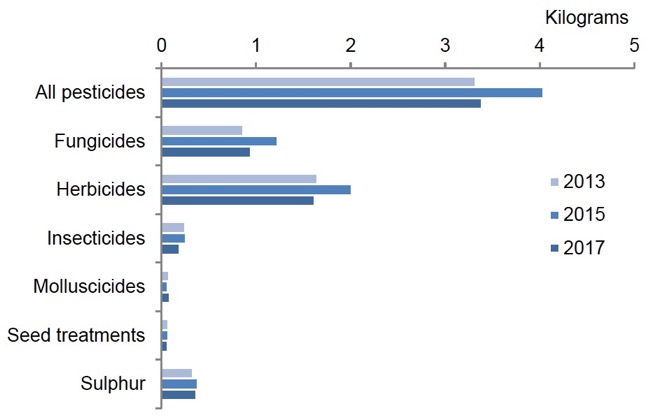
Note: growth regulators, biopesticides and physical control have been excluded as their use represents <0.1 kg per hectare of crop grown
Fungicides were the most frequently used pesticides by area treated on outdoor vegetable crops, followed by herbicides and insecticides (Figure 7). This was the same pattern observed in the previous survey (Figure 3). In 2017, fungicides accounted for almost a third (32 per cent) of the total pesticide treated area and 28 per cent of the total weight of pesticides applied (Figures 7 & 8). When changes in crop area are taken into account, the area treated with fungicides decreased by 21 per cent from 2015 to 2017 but has increased by four per cent between 2013 and 2017 (Figure 5). From 2015 to 2017, there was a decrease of 23 per cent in the weight of fungicides used per hectare of crop grown, but an increase of 10 per cent between 2013 and 2017 (Figure 6). The decreased use of fungicides in 2017 compared with 2015 may be influenced by the weather. Scotland experienced a considerably drier spring in 2017 than in 2015 (39 per cent decrease in rainfall (5)) which may have resulted in lower disease pressure. Fungicide use in 2017 was similar to use in 2013 which was also a low disease year (4). In comparison with the previous survey in 2015, there were decreases in fungicide use across all modes of action, with the exception of those affecting respiration which increased by 10 per cent (this group includes strobilurins and SDHIs, Table 16).
Sulphur accounted for two per cent of the total treated area and 11 per cent of the total weight of pesticides applied (Figures 7 & 8). Foliar use of sulphur has both fungicidal and fertilising properties. When changes in area grown are taken into account there was a 18 per cent decrease in the use of sulphur between 2015 and 2017 and a 34 per cent increase between 2013 and 2017 (Figure 5). The weight of sulphur applied per hectare of crop grown decreased by two per cent from 2015 to 2017 and increased by 11 per cent between 2013 and 2017 (Figure 6). The majority of sulphur use was on calabrese and vining peas which have both seen increases in crop area ( Table 21).
In 2017, herbicides accounted for 27 per cent of the total pesticide treated area and 48 per cent of the total weight of pesticides applied (Figures 7 & 8). When changes in crop area are taken into account, there is a decrease in area treated with herbicide formulations of 20 per cent from 2015 to 2017 and eight per cent from 2013 and 2017 (Figure 5). In terms of weight of pesticide applied, when area of crop grown is taken into account, there was a decrease of 19 per cent from 2015 to 2017 and a decrease of two per cent from 2013 to 2017 (Figure 6). It is possible that herbicide use is influenced to some extent by grower utilisation of mechanical weeding technology. In the 2015 survey of integrated pest management ( IPM) by vegetable growers, 36 per cent of respodents used mechanical weeding as well as, or instead of, herbicides (3). The next survey of IPM in vegetable crops is scheduled for the 2019 crop season. Despite the overall decrease in herbicide use there were some increases in individual active substances. For example, the area treated with the herbicide MCPB increased by 72 per cent by area treated and by 104 per cent by weight. There are no clear temporal trends in relation to herbicide modes of action ( Table 17).
Figure 7 Use of pesticides on outdoor vegetable crops – 2017 (percentage of total area treated with formulations)
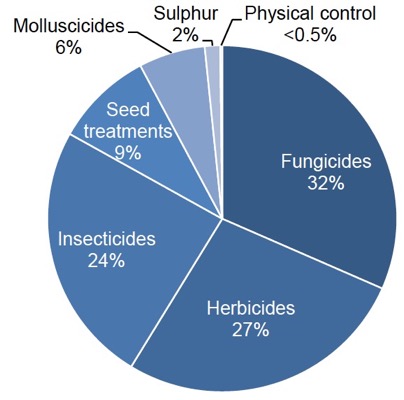
Figure 8 Use of pesticides on outdoor vegetable crops (percentage of total weight of pesticides applied) – 2017
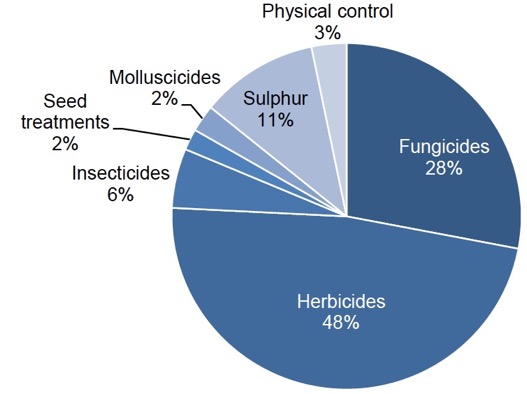
Insecticides accounted for 24 per cent of the total pesticide treated area and six per cent of the total weight of pesticides applied (Figures 7 & 8). When changes in crop area are taken into account, there was a 19 per cent decrease from 2015 to 2017 and a 17 per cent decrease from 2013 to 2017 in the area treated with insecticide formulations (Figure 5). Similarly, in terms of weight applied per hectare of crop grown, there was a decrease of 26 per cent from 2015 to 2017 and a decrease of 25 per cent from 2013 to 2017 (Figure 6). There were also changes in the types of insecticides encountered in the 2017 survey ( Table 15). Overall, use of the carbamate insecticide pirimicarb halved in comparison with the previous survey, reflecting its loss of approval on a range of vegetable crops in July 2017, half way through the field season. Pirimicarb is now approved only for peas and beans, leaving fewer options for aphid control. Pyrethroid use per hectare, whilst still the principal form of insect control employed, also decreased in the 2017 survey. Use of insecticides with other modes of action (thiacloprid, spinosad, pymetrozine and indoxacarb) all increased, suggesting that these alternatives, rather than pyrethroids, replaced the lost pirimicarb authorisations. This is likely to be related to the pyrethroid resistance status of a number of target species.
Over 96 per cent of leaf brassica crops and 43 per cent of other vegetable crops were grown from transplants. The remaining crops were grown directly from seed. Of these, vining peas had the highest proportion of treated seed with 100 per cent treated, followed by broad beans (99 per cent) and turnips & swedes (96 per cent). Seed treatments accounted for nine per cent of the total area treated and two per cent of the total weight applied (Figures 7 & 8). When changes in crop area are taken into account, there was a decrease in area treated with seed treatments of 18 per cent from 2015 to 2017 and a decrease of 12 per cent from 2013 to 2017 (Figure 5). The weight of seed treatment applied per hectare of crop grown decreased by seven per cent from 2015 to 2017 and by eight per cent from 2013 to 2017 (Figure 6).
Molluscicides accounted for six per cent of the total pesticide treated area and two per cent of the total weight of pesticides applied (Figures 7 & 8). When changes in crop areas between years are taken into account, there was an increase in molluscicide applications per unit area of 37 per cent between 2015 and 2017 and an increase of 14 per cent between 2013 and 2017 (Figure 5). The weight of molluscicides applied per hectare of crop grown increased by 32 per cent from 2015 to 2017 and by four per cent from 2013 to 2017 (Figure 6). Molluscicide usage varies greatly from year to year as slug population levels are closely linked to climatic conditions. There were reduced levels of slug activity in 2015 due to the late cold spring (3). In contrast, the wet summer months in 2017 helped increase the risk of slug damage (6). The use of the molluscicide ferric phosphate, increased by 158 per cent (area treated) and 132 per cent (weight) (Tables 18 & 19). This increase may have been influenced by the loss of approval of methiocarb in September 2015 and the current industry led stewardship scheme which aims to minimise the environmental impacts of metaldehyde use. Metaldehyde use showed little change between the surveys. Ferric phosphate and metaldehyde are currently the only approved molluscicide active substances.
Pesticides classified as physical control accounted for less than 0.5 per cent of the total pesticide treated area and three per cent of the total weight of pesticides applied (Figures 7 & 8). In 2017 all physical control encountered was garlic-containing granules. This pesticide, which is approved for use against free-living nematodes, was only applied to carrot crops. No physical control was encountered in 2015, but a similar proportion of the carrot crop was treated with garlic in the 2013 survey.
No growth regulators or biopesticides were encountered during the 2017 survey. In the previous survey growth regulators and biopesticides accounted for less than one per cent of the total pesticide treated area each. The fungicides isopyrazam and epoxiconazole and the herbicide clethodim were recorded for the first time on outdoor vegetable crops in 2017 ( Table 14).
Contact
There is a problem
Thanks for your feedback